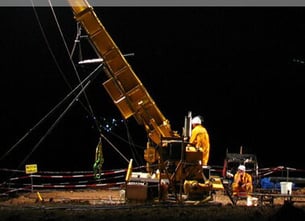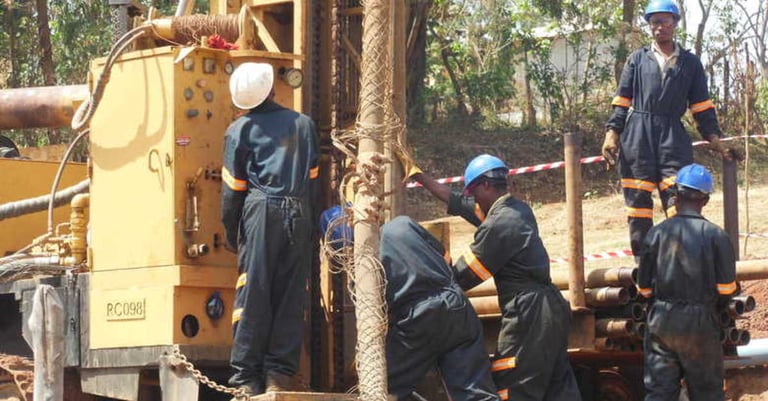KEFI Minerals plc (LON: KEFI), the gold exploration and development company with projects in the Federal Democratic Republic of Ethiopia and the Kingdom of Saudi Arabia, has today provided an update on exploration activities at the Company’s Hawiah Exploration Licence in Saudi Arabia.
Drilling rig and team have been mobilised to Hawiah for a programme designed to test the extent of the gold mineralisation in the upper oxidised zone as well as for a significant subsurface copper-gold-zinc deposit.
This will be an initial 2,500 metre scout drilling programme along what is currently judged to be the most prospective portion of the gossanous ridgeline at Hawiah. Previous work has shown that this area is enriched in gold and has abundant secondary copper showings. Geophysical surveys have identified a strong and continuous anomaly under this ridge that indicates massive sulphide mineralisation is likely to be present 50-300 metre below the ridge.
High-priority drill targets have been defined towards the southern end of the gossanous ridgeline by interpretation of:
· results from the recently completed induced polarisation and resistivity (“IP/Rho”) geophysical survey;
· interpretation of geochemical data collected from trenches across the ridgeline; and
· geological mapping confirming that the sequence of rocks across the ridgeline conform with the expected zonation across a volcanogenic massive sulphide (“VMS”) deposit.
The above work has provided a more robust interpretation of the geometry of the potential primary base-metal sulphide mineralisation. Initial drilling is planned to target the strongest copper grades which overlie the strongest IP/Rho geophysical anomaly.
Hawiah is located in Saudi Arabia’s Wadi Bidah Mineral District which is a 120-kilometre-long copper-gold-zinc VMS belt where over 24 VMS occurrences were defined by the US Geological Survey and French Geological Survey over many years of research.
KEFI is the operating partner of Gold & Minerals Limited (“G&M”), the joint venture company with the Company’s long-standing partner, Saudi conglomerate ARTAR. This joint venture has registered applications for an additional eight licence areas within the Wadi Bidah Metallorgenic Belt. The issuance of these additional licences will give G&M a dominant position in this area.
Commenting KEFI Minerals plc Executive Chairman, Mr Harry Anagnostaras-Adams, said,
“We are pleased that drilling of our Hawiah prospect in Saudi Arabia has commenced.
“Hawiah has all the hallmarks of being a great target within a significant copper-gold-zinc VMS district. Major deposits have already been discovered and developed in the Arabian Nubian Shield and we are confident of positive results from our exploration programme, the results of which we will report as results warrant over the coming weeks and months.”
Background on Hawiah
The Hawiah prospect is located in the southwest of the Arabian Shield and the planned exploration programme aims to:
• define a near-surface, economic gold resource in the gossanous ridge; and
• simultaneously search for a major copper-gold-zinc sulphide ore body at depth.
Hawiah is one of KEFI’s higher priority prospects as the geological setting is analogous to other large VMS deposits in the Arabian-Nubian Shield that have well-preserved, mature oxidised zones enriched in gold at surface.
Initial surface exploration has confirmed that the main gossanous ridgeline is enriched in gold and the mineralisation has good continuity along strike and has abundant secondary copper showings. KEFI’s Self Potential (“SP”) and induced polarisation (“IP”) geophysical surveys indicate it is underlain by a large and continuous conductive body.
Hawiah’s silicified and gossanous horizon was mapped and trenched by the French Geological Survey (“BRGM”) in the 1980s, which identified its gold-bearing and VMS potential.
In February 2015, KEFI completed a first-pass, wide-spaced trenching programme over the gossanous horizon. KEFI’s trenches repeated all of the BRGM’s trenches, as well as extending the known (4.5km) exposure to the south and to the north. All of KEFI’s trenches contained anomalous gold, including 6m at 2.2g/t gold, 2m at 8.7g/t gold, 6m at 1.9g/t gold, 3m at 5.8g/t gold, 2m at 7.5g/t gold and 8m at 3.0g/t gold.
The results from the BRGM and KEFI trenches both confirm that gold grades occur with good continuity along the strike length, as well as across the ridge. All of the KEFI trenches returned strongly anomalous copper with most having a highest assay of > 1,000ppm copper. Ten of the 53 trenches returned highest assay of > 10,000ppm (>1%) copper.
In order to evaluate the deeper VMS potential, KEFI has used geophysics and geochemistry to define drill targets. SP geophysical surveys were completed over the gossanous horizon during 2015 and 2016. Two strong anomalies were identified. The most prominent of these anomalies is an intense north-south trending SP anomaly with a continuous maxima of 350 millivolts, located between 125m and 300m below surface with an 800m strike length. The intensity of this anomaly is consistent with the presence of a massive sulphide source, or to a high and contiguous concentration of disseminated sulphides at depth.
The targets generated by the SP survey were recently followed-up with a more detailed and deeper penetrating IP/Rho survey. The IP/Rho survey confirmed the presence of a continuous anomaly below the main gossanous ridgeline with a signal corresponding to that of massive sulphide mineralisation, but revealed the Eastern SP anomaly to be a response to a geological thrust.
The broad structure, lithology and mineralisation styles at the Hawiah ridge are typical of an oxidised VMS palaeosurface horizon. The predominantly leached, iron-oxide rich package found at surface is typical of the basic weathering profile for VMS deposits. The secondary copper mineralisation at surface is considered a meaningful proxy for copper mineralisation at depth.
The southern area of the Hawiah ridgeline presents with the highest base metals in trench assay as well as the strongest geophysical responses. For these reasons, this area is the priority for the initial drilling program.
Applications for Saudi exploration licences are currently on hold pending the finalisation of the new mining law. The new mining law is a part of the Vision 2030: National Transformation Program 2020. This initiative will overhaul all Saudi government sectors and deliver investment, transparency and a new online platform for mining licence applications and management. The new mining law is expected to be passed by Royal Decree in line with the 2020 target.






































